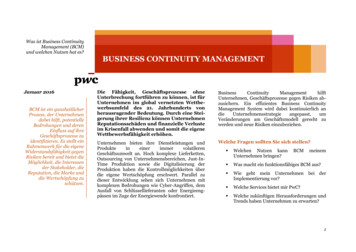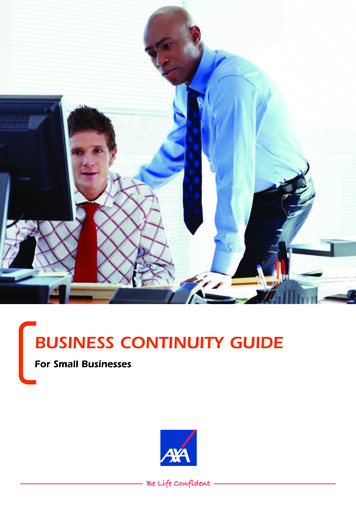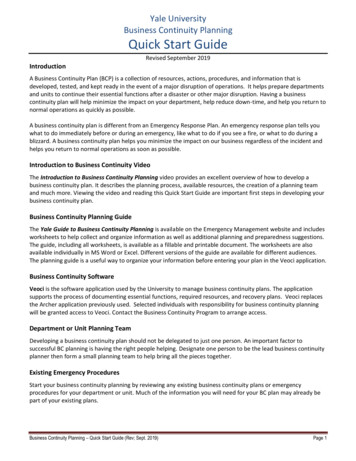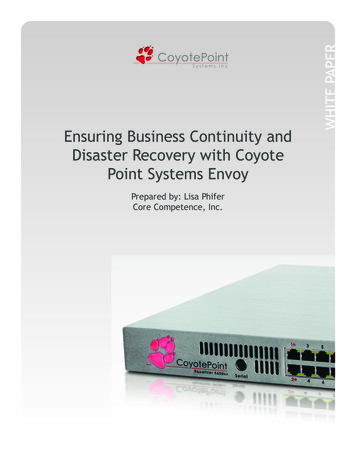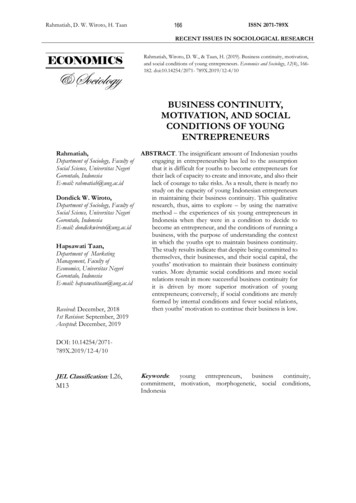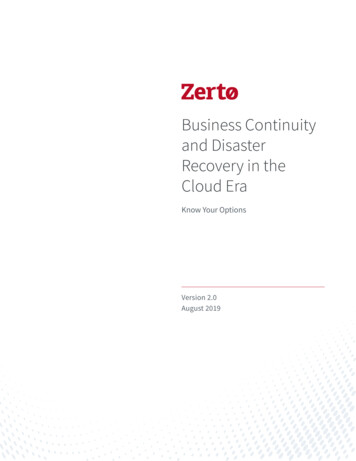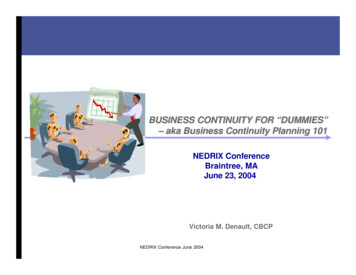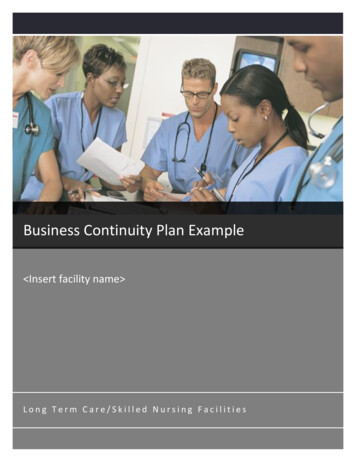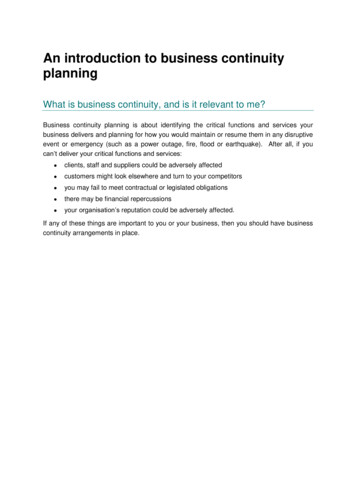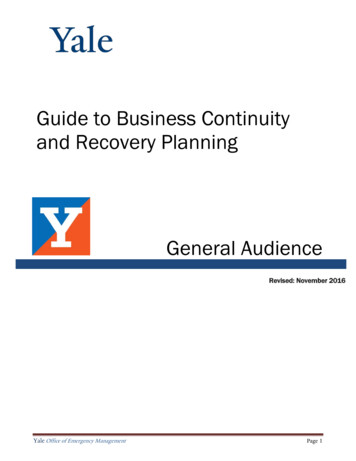
Transcription
Guide to Business Continuityand Recovery PlanningGeneral AudienceRevised: November 2016Yale Office of Emergency ManagementPage 1
Table of ContentsSection 1 - Business Continuity PlanningIntroductionHow to Use the GuideGetting StartedDepartment or Business Unit ProfileIdentify Important ContactsDetermining Your Essential FunctionsPrioritizing Your Essential FunctionsConducting a Business Impact AnalysisDetermining Essential ResourcesSpecialized Supplies and Essential VendorsSpecialized EquipmentLoss of PowerLoss of Basic UtilitiesInformation TechnologyEmergency RelocationMinimum Site RequirementsAlternate Site RequirementsDeveloping Recovery Strategies and TasksEmergency Communication and NotificationEmployee PreparednessTesting and Exercising Your PlanSummary and Next StepsMitigation and Follow-Up ActionsBusiness Continuity WorksheetsDepartment or Business Unit ProfileImportant ContactsEssential Function and Business Impact AnalysisSpecialized SuppliesEssential VendorSpecialized EquipmentVital DocumentsComputer Drives, Files, FoldersMinimum Site RequirementsAlternate Site InformationRecovery PlanningMitigation/Follow-Up ActionsYale Office of Emergency ManagementSection 2 - Business Continuity Response GuideIntroductionImmediate ActionsConducting a Damage AssessmentDetermining Business DisruptionDetermining Plan of ActionRelocation ChecklistKey Contacts to Help in your RecoveryOngoing Communications withStaff/Students/ClientsFinancial RecoveryResponse Attachments1. Individual Damage Assessment Worksheet2. Recovery Contacts Worksheet3. Staff Relocation WorksheetAcknowledgmentsSpecial thanks to the following for theirsupport and contributions:Yale BC/DR Advisory Council, Yale EnvironmentalHealth & Safety, Yale Information TechnologyServices, Yale Animal Resources Center,Yale Medical Group, andThe University of North Carolina at Chapel Hill.Page 2
IntroductionAlthough infrequent, disasters and emergencies of all types and severity can occur, often with little or nowarning. Consider the following situations: A fire breaks out in your office or an adjacent office, forcing you to evacuate the building A sprinkler head malfunctions and floods your office A blizzard paralyzes Connecticut, closing many roads and highways for three days A pandemic flu has sickened 50% of your staff While you cannot control when and where such events will occur, you can manage your ability to maintainoperations and continue your essential functions through effective business continuity planning.A business continuity plan (BCP) is a collection of resources, actions, procedures, and information that isdeveloped, tested, and held in readiness for use in the event of a disaster or major disruption of operations.A comprehensive business continuity plan will help you maintain your central business activities while limitingthe economic impact and allowing you to return to normal operations as quickly as possible.This guide has been developed to help departments and business units develop a business continuity plan toensure that essential business activities can continue following a disaster or major disruption.A business continuity plan is different from an emergency plan. An emergency plan tells you what to doimmediately before or during an emergency, like what to do if you see a fire, or what to do during a blizzard orice storm. A business continuity plan helps you minimize the impact on your business operations regardless ofthe incident and helps you return to normal operations as soon as possible.How to Use the GuideThis guide consists of two sections. The first section will help guide you in the creation of a business continuityplan. It includes helpful information as well as useful worksheets to help collect vital information. Note: Not allsections may apply to your particular department or business unit. Feel free to skip any section that does notapply, or adjust the information to meet your individual needs.As you develop your continuity plan, you will inevitably identify things that are needed to help you be betterprepared. It is important to capture these suggestions during the planning process. There is aMitigation/Follow-Up Actions Worksheet at the back of the guide to help capture and manage the suggestions.Once you have completed the first section of this guide, you will want to enter the information into thebusiness continuity program software application called Archer. Archer is a cloud-based program that ensuresyou have uninterrupted access to your information. The system is maintained by the Office of EmergencyManagement and is part of Yale’s overall emergency management and business continuity program. Contactthe Business Continuity Program Manager at bcmanagement@yale.edu for information about entering yourplan into the Archer application.The second section is a response guide to use in the event of a disaster or major disruption to your departmentor business unit. The response guide will walk you through steps to take as you assess the damage anddetermine a plan of action. The Office of Emergency Management is also available to assist following a disasteror major disruption.Yale Office of Emergency ManagementPage 3
Getting StartedDeveloping a business continuity plan may seem like an overwhelming task, but in reality you probablyalready have most of the required information and procedures. This guide will help walk you through theplanning steps in a logical order. Don’t do this alone. Business continuity planning is everyone’s responsibility. Develop a planningteam to help bring all the pieces together. Schedule regular meetings with the planning team. Start with one-hour meetings once a week forfour weeks. Add additional meetings as needed. Follow this guide and complete the tasks and worksheets. Review existing plans such as your department or building’s Emergency Plan. They may providehelpful information for developing your business continuity plan.If you have any questions about this guide, or if you need additional assistance in your business continuityplanning, contact the Business Continuity Program Manager at bcmanagement@yale.edu.Department or Business Unit ProfileThe Department or Business Unit Profile provides basic information about your department or business unit aswell as information about any existing emergency or business continuity plans. Task: Complete the Department / Business Profile worksheet below.Department / Business Unit ProfileDepartment / Unit name:Department / Unit Director:Street address:Mailing address (if different):Person to contact to discuss emergency planning:Number of staff:Staff who are part of department Emergency Team:Do you have an emergency plan? No Yes: Last time it was revised:Do you have a business continuity plan? NoDoes your facility have a backup generator? NoYale Office of Emergency Management Yes: Last time it was revised: Yes: What does it power:Page 4
Identify Important ContactsKnowing who to contact in an emergency is critical. Start your business continuity planning by identifying theimportant contacts for your department or unit. Managers and supervisors should keep a copy with them at alltimes. If you are like most people, you probably keep all of your contacts in your cell phone. But what if youlost your phone? Do you have a backup copy of your contacts? How long would it take to reconstruct yourcontacts list? A little pre-planning now can save valuable time later.Other ContactsIn addition to your primary emergency contacts, you will also want to maintain updated lists of all employees,interns, students, postdoc’s, essential vendors, and others. Include after-hours contact information if available.Keep copies readily accessible and in multiple locations. Consider e-mailing the lists to yourself and savingthem in a special folder so you can access them from any location. Regularly review, update, and distribute allcontact lists. Task: Complete the Important Contacts Worksheet. Add any department or Unit specificcontacts as needed. Give a copy to everyone on your emergency planning team. Task: Create contact lists for important contact (employees, Interns, students, postdocs, etc.).Yale Office of Emergency ManagementPage 5
Important Contacts WorksheetDepartment / Unit Name:Street Address:Department ChairName:Email:Department DirectorName:Email:Department ManagerName:Email:Lead AdministratorName:Email:Business Office il:Title:Name:Email:Title:Name:Email:Facilities SuperintendentName:Email:Environmental Health and Safety AdvisorName:Email:ITS Support ProviderName:Email:Yale ITS Help DeskYale Office of Emergency ManagementBusiness phone:Cell phone:After hours phone:Business phone:Cell phone:After hours phone:Business phone:Cell phone:After hours phone:Business phone:Cell phone:After hours phone:Business phone:Cell phone:After hours phone:Business phone:Cell phone:After hours phone:Business phone:Cell phone:After hours phone:Business phone:Cell phone:After hours phone:Business phone:Cell phone:After hours phone:Business phone:Cell phone:After hours phone:Business phone:Cell phone:After hours phone:Business phone:Cell phone:After hours phone:Business phone:Cell phone:After hours phone:Main Number: (203) 785-3550Cell phone:EMERGENCY: (203) 785-3555Business phone:Cell phone:After hours phone:helpdesk@yale.edu(203)-432-9000Page 6
Determining Your Essential FunctionsA major part of business continuity planning is identifying functions that define your operations. These arecalled Essential Functions. Essential functions are those services, programs, or activities that are necessary toon-going business of your department and would directly affect the success of your department if they were tostop for an extended period of time. The success of your department and the support you provide to theUniversity rely on these functions. Stopping them for an extended period of time would cause an unacceptabledisruption to your operations and possibly other departments or units as well.Your essential functions will serve as your guide for how to restart your operations following a disaster ormajor disruption. They help answer the question “What is the minimum level of service or activity mydepartment must offer to still be in business?” By identifying and prioritizing your essential functions, you candetermine which personnel, facilities, equipment, and materials are absolutely necessary to keep yourdepartment functioning following a disaster or major disruption. Prioritizing your functions will also help youdetermine the Recovery Time Objective (RTO) – the length of time the function can be suspended withoutcausing an unacceptable disruption to your operations.One way to determine your essential functions is to look at your department table of organization. This shouldhelp your identify the general functions that you preform. Asking each staff member to make a list of theiressential duties and responsibilities is another way to determine your essential functions.In general you should be able to organize your operations into four to six essential functions, more if you are ahighly complex department or unit. If your list of functions is long, consider grouping similar activities into asingle function. Example: General Office Management can include all administrative tasks. Manage ITS caninclude all IT tasks such as updating your website and troubleshooting computer issues.Prioritizing Your Essential FunctionsWhile everything you do each day may seem essential, in reality some functions and activities are moreessential than others. Some activities can be suspended for several weeks, while others cannot stop for morethan a few hours. Knowing the priorities of your functions will help you establish a recovery plan that focuseson the functions that are the most important. The following chart provides general guidance to help youprioritize your functions. Completing the business impact analysis (BIA) with also help determine the priorityfor each function.Conducting a Business Impact AnalysisA Business Impact Analysis (BIA) is completed for each essential function to help assess and documentpotential impacts and negative consequences of a disaster or major disruption on the function. Completing aBIA also helps establish recovery priorities by looking at dependencies, peak periods, harmful consequences,and financial risks. The BIA is a formal process to set the criticality (priority) for each function and is included aspart of the Essential Function and Business Impact Analysis Worksheet.Note: The BIA section of the worksheet is designed to be generic and used by a variety of different departmentsand operating units.Yale Office of Emergency ManagementPage 7
General Criticality and Priority RatingsPriority RatingImportanceRecovery TimeFunction directly impacts the life, health, safety, or security of the Yale communityand stopping would have significant consequences. 4 hoursHighFunction must continue at normal or increased level. Pausing for more than 24 hoursmay cause significant consequences or serious harm to business operations,upstream and downstream dependent organizations or units, revenue and finances,reputation, or other core mission services. 24 hoursMediumFunction must be continued if at all possible, perhaps in reduced mode. Stopping formore than one week may cause major disruption to business operations, upstreamand downstream dependent organizations or units, revenue and finances, or othercore mission services. 1 weekFunction could be suspended for up to one month without causing significantdisruption to business operations, upstream and downstream dependentorganizations or units, revenue and finances, or other core mission services. 1 monthFunction may pause and resume when conditions permit. Deferring this function formore than one month may cause slight disruption to business operations, upstreamand downstream dependent organizations or units, revenue and finances, or othercore mission services. 1 monthCriticalLowDeferrable Task: Complete an Essential Function and Business Impact Analysis Worksheet for each functionyou have identified. Additional copies of the worksheet can be downloaded from the BusinessContinuity section at http://emergency.yale.edu.Yale Office of Emergency ManagementPage 8
Essential Function and Business Impact Analysis WorksheetInstructions: Complete one worksheet for each essential function for your department or unitOrganization or DepartmentEssential FunctionBrief DescriptionWhat is this function responsible for?What does it accomplish?RatingPriority Rating RTORTO Recovery Time Objective(Maximum time this function can bedown before significant problemswould occur)Key Personnelfor this Function Critical High Medium Low DeferrableDescriptionDirectly impacts life, health, safety, or security. Cannot stop.Must continue at normal or increased level. Pausing for more than 24 hoursmay cause significant consequences or serious harm.Must continue if at all possible, perhaps in reduced mode. Stopping for morethan one week may cause major disruption.May be suspended for up to one month without causing significant disruption.May pause and resume when conditions permit.RTO 4 hours 24 hours 1 week 1 month 1 monthPrimary:Alternate:Alternate:Key Roles Required to Performthe Function (Admin Asst., RN,manager, financial analysis, etc.)Vendors Vital to this FunctionRESOURCE REQUIREMENTSRequired ITS Products andServices Network Services Yale Connect (Email) Telephone CAS VPN EpicOthers:Required ITS ApplicationsEssential External WebsitesRequired FacilitiesVital Records andPrivate InformationDEPENDENCIES and PEAK PERIODSUpstream DependenciesOther departments vital to thisfunction that you rely onDownstream DependenciesOther departments that relyon this functionPeak PeriodsSignificant or demanding monthsfor this functionYale Office of Emergency ManagementPage 9
HARMFUL CONSEQUENCESSuppose the essential function is not resumed quickly following a major disruption or disaster. Which of the listed harmfulconsequences might occur, and how long after the disaster might the harm begin to occur? Check (X) the box to indicate whenharm might occur. Select N/A if the consequence does not apply to the essential function you are evaluating.How long after a disaster might the harm occur?Possible Harmful ConsequenceN/A1Disruption of teaching?2Disruption of research?3Departure of faculty?4Departure of staff?5Departure of students?6Well-being of staff/faculty?7Well-being of students?8Payment deadlines unmet by campus?9Loss of revenue to campus?10Legal obligations unmet by campus?11Legal harm to the University?12Impact on other campus unit(s)?13Impact on important business partner(s)?14Impact on Yale’s brand image?15Function without power?16Other harmful consequence?0-2days1week2weeks3weeks4weeks 4weeksCommentsFINANCIAL IMPACTSSuppose the essential function is not resumed quickly following a disaster. What might be the financial consequences for eachtime period, if any, if this function is not restored? Check (X) the box to indicate the possible financial impact.Loss of RevenueHow much revenue would the departmentor the university loose in each time periodUp to 1 week1 - 4 weeks1 - 3 months3 - 6 monthsDelayed ReceiptsIf unknown, skip this section.Operational CostsNone 10k 10k - 50k 50k - 250k 250k - 500k 500kNone 10k 10k - 50k 50k - 250k 250k - 500k 500kNone 10k 10k - 50k 50k - 250k 250k - 500k 500kUp to 1 week1 - 4 weeks1 - 3 months3 - 6 monthsCosts the department or University mightincur if the function is not restoredquickly? Skip if unknown.Up to 1 week1 - 4 weeks1 - 3 months3 - 6 monthsYale Office of Emergency ManagementPage 10
Essential Function and Business Impact Analysis WorksheetInstructions: Complete one worksheet for each essential function for your department or unitOrganization or DepartmentEssential FunctionBrief DescriptionWhat is this function responsiblefor? What does it accomplish?RatingPriority Rating RTORTO Recovery Time Objective(Maximum time this function canbe down before significantproblems would occur)Key Personnelfor This Function Critical High Medium Low DeferrableDescriptionRTODirectly impacts life, health, safety, or security. Cannot stop.Must continue at normal or increased level. Pausing for more than 24 hoursmay cause significant consequences or serious harm.Must continue if at all possible, perhaps in reduced mode. Stopping for morethan one week may cause major disruption.May be suspended for up to one month without causing significant disruption.May pause and resume when conditions permit. 4 hours 24 hours 1 week 1 month 1 monthPrimary:Alternate:Alternate:Key Roles Required to Performthe Function (admin asst., RN,manager, financial analysis, etc.)Vendors Vital to This FunctionRESOURCE REQUIREMENTSRequired ITS Products andServices Network services Yale Connect (e-mail)Others: Telecom CAS VPN EpicRequired ITS ApplicationsEssential External Web SitesRequired FacilitiesVital Records andPrivate InformationDEPENDENCIES and PEAK PERIODSUpstream DependenciesOther departments vital to thisfunction that you rely onDownstream DependenciesOther departments that relyon this functionPeak PeriodsSignificant or demanding monthsfor this functionYale6 Office of Emergency ManagementYale Office of Emergency ManagementPage 6
termighttheharmbegintooccur?Check(
business continuity program software application called Archer. Archer is a cloud-based program that ensures you have uninterrupted access to your information.
